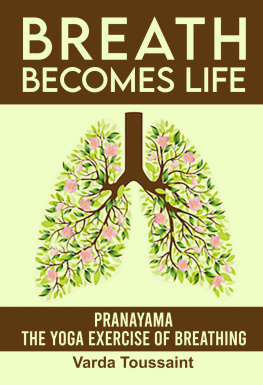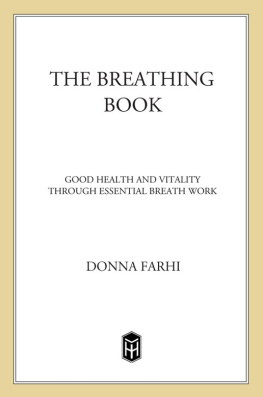
RESTORING
PRA
A Theraputic Guide to Pryma and Healing
Through the Breath for Yoga Therapists,
Yoga Teachers, and Healthcare Practitioners
ROBIN L. ROTHENBERG
Foreword by Richard Miller
Illustrated by Kirsteen Wright

C ONTENTS
F OREWORD
On a cold and windy evening in 1981, I found myself standing next to a stately Tibetan lama during opening ceremonies for a national yoga conference. We were outside and he was dressed in a thin wrapping of light cloth. I was chilled to the bone, shivering, while bundled in a down jacket. Before heading inside to warm myself, I turned to greet the lama. He kindly enfolded my hands in his and I was immediately struck by how his hands were like fire while mine were ice. Oh, you poor boy!, he exclaimed. Your hands are so cold. In speaking with him, I came to understand that he had been able to keep himself toasty in this coldest of weather by using the powers of yogic breathing to regulate his body temperature. Such strategies have rendered yoga masters the capacity to cool themselves while surrounded by blazing fires in summer, and simultaneously retain their body heat while wrapped in frozen blankets in the dead of winter. Impressed with this living lamas example, I vowed to pursue my practice of pryma more diligently. That commitment has stood me in good stead ever since.
When I began learning the art of pryma in the 1970s, I asked my teachers to explain the science behind this life-enhancing practice. Their answers left me wanting. They simply stated, Trust me. As a Westerner Im willing to trust, but I also yearn to know the science that lies behind the practices in which I am engaged. Over the years, Ive combed the research literature on respiration to understand more of the hows and whys that make pryma so extraordinarily effective on the physical, psychological, and spiritual levels. So, it is was my great fortune to be asked to review and then write this foreword to Robin Rothenbergs text, Restoring Pra .
Robin emphasizes throughout this book that regular practice of pryma is like putting money in the bank. She describes how the breath is a driving force behind every process throughout the body, including regulating our immune system. It is vital to maintaining our physical and psychological homeostasis and, as with my Tibetan Lama friend, has the power to keep us warm on a frigid night. We take over 24,000 breaths and exchange over 10,000 gallons of air in our lungs every day of our lives. During the past 71 years I have taken over 597,081,600 breaths, at least 38,340,000 of which have been during my practices of hatha, pryma, and meditation. With these kinds of figures, its easy to see how breathing plays a significant role in our daily life and our practice of yoga.
Resonant with Robins description of personal transformation, I too have experienced the sustained impact of pryma practice to enhance my reserves of health, energy, and vitality. In the early 1980s, I spent a minimum of an hour a day practicing pryma. This afforded me a veritable fortune of pra. I was able to draw upon this savings account while working on my doctoral dissertation. For those three years, even though my practice was less regular, I felt vibrantly alive and healthy, with an abundance of energy. However, during the fourth year, I found myself becoming vulnerable again to colds and flu. With my pra account depleted, I realized it was time to get back to my daily practice of pryma.
In the Yoga Stra the sage Patajali recommends the breath as a means for overcoming mental distractions that prevent us from understanding our Essential Nature. He understood that as breath slows and grows calm, so follows the thinking mind. This allows a doorway for meditation to open whereupon we have the ability to glimpse what lies beyond the dividing mind: our underlying Essential Nature of unbreakable peace and well-being. Patajali specifically recommends exhalation and suspension after exhalation to balance and refine the flow of energy within ourselves, sharpen concentration, and hone our powers of observation. This helps us to discern how our actions, thoughts, and emotions color and distort our perception of reality. In this way, the breath sculpts away excess to reveal essence.
Contained within the etymology of the word pryma are the secrets of this sophisticated science. The Sanskrit syllable pr implies spiritual energy that descends from above. a represents the eternal divine vibration within us, which allows us to evolve spiritually. Y implies the ability to harness, build upon, and put into action this spiritual force. And ma simultaneously represents the mother principle of the universe and our ability to modulate this energy through the breath. Yma implies something that is moving and ayma means extending, lengthening, and ascending. And Pr with a large P represents the animating principles behind all of life, while pra with a small p represents the life-force that infuses our body with life. Essentially, the word pryma means, To be living in, as, and nurtured by the life-force energy that has given rise to the entire universe. Pryma infuses our body and mind, with pr which flows through us with each breath we take. Pra represents the life-force that gives birth to and sustains life and ayma is the way we learn how to experience and extend this energy within our body, throughout our daily life, by learning to work consciously with the breath.
Countless texts have been written through the centuries on pryma in which step-by-step methodologies are offered as means for developing proper breathing habits. The ancients understood that breath is a vehicle for delivering and distributing live-giving essence (pra) to every cell throughout our body. And while these texts explain in detail the techniques of pryma, none have fully explained the hows and whys of the underlying mechanisms that make these techniques so effective.
Robin has done us a great service in compiling modern research, understandings of physiology, and practices that underlie the science of pryma. Her writing draws upon years of experience as both a student-practitioner and teacher of pryma. She writes with the passion of one who has wrestled deeply to understand this precious tradition from the inside out, and from the outside in, in order to help herself, those she serves, and now us as readers who are interested in plumbing the depths of this ancient practice. This is an important book that supports the evolution of pryma into this modern era. This is a book to be read and reread, over and over again, as it contains priceless gems that can only be gleaned from our heartfelt commitment to thoroughly immerse ourselves in the wisdom contained in each chapter.
We can never know what an apple tastes like until we take a bite of an apple. We can never know the fruits that practicing pryma can bring to our lives unless we dive into its practice. Like any form it requires patience, persistence, and perseverance. I hope you will, as Robin and I have, take to this precious practice. Each breath you take can be life-enhancing: a step in the direction of experiencing vibrant health, healing, wholeness, and well-being. Ultimately it holds the power to reveal the mystery of the Essential Nature that underlies and connects us all with the entire universe.
Could any practice be more timeless? Could any practice be more vital? Could any book be more needed? Dive into this delicious text that Robin offers. Study. Practice. Then pass on what you understand to those you meet. This is what Robin has done by revealing this book of secrets that are now open secrets to everyone who practices this ancient art that Robin has so beautifully placed in our hands.
Next page









